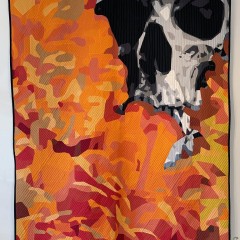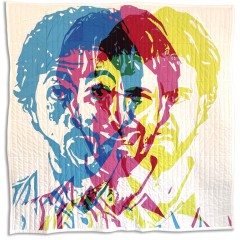Scott Culley habe ich im September 2022 beim Carrefour Européen du Patchwork kennengelernt und war beeindruckt von seinen Arbeiten und der Selbstreflektion, die darin zum Ausdruck kommt. Ich habe ihm Fragen gestellt.
Wo sind Sie aufgewachsen und wo leben Sie jetzt?
Ich bin im Bundesstaat Washington in den Vereinigten Staaten aufgewachsen und habe mein Architekturstudium in Boston absolviert. Derzeit lebe ich mit meiner Familie im Prenzlauer Berg, Berlin.
Was ist Ihr textiler Hintergrund?
Ich habe keinen formalen Hintergrund in Sachen Textilien. Während des Architekturstudiums habe ich hin und wieder genäht, kleine Dinge wie Stofftiere, und ich habe mit nicht-traditionellen Materialien experimentiert. Als ich ein Haus renoviert habe, zeigte mir meine Kundin ein Projekt, an dem sie gerade arbeitete. Sie führte mich in ihr Nähzimmer, wo sie einen Memory-Quilt aus den Kleidern ihrer Mutter quiltete. Diese Idee hat mich umgehauen. Aus Erinnerungen etwas Materielles zu schaffen, war etwas, das ich noch nie gesehen hatte und das mich wirklich ansprach. Einige Jahre später belegte ich meinen ersten Patchwork-Kurs. Man brachte mir traditionelle Patchworkblöcke bei, aber die Ästhetik sprach mich nicht an. Erst als ich die moderne Quiltbewegung und das Foundation Paper Piecing entdeckte und die Möglichkeit, meine eigene Bildsprache zu kreieren, begeisterte mich das Quilten wieder.
Was reizt Sie am Textilen als Kunstform?
Im Herzen bin ich ein Macher, das war ich schon als Kind. Ich finde es interessant, dass ich all diese Stoffstücke nehmen und daraus etwas Gegenständliches machen kann, das meine innersten Gedanken und starke Gefühle ausdrückt.
Welche Techniken verwenden Sie?
Ich verwende Foundation Paper Piecing (FPP). Bei FPP wird das Quiltmuster auf Papier gedruckt und der Stoff auf das Papier genäht. Sobald die Quiltoberseite vollständig zusammengenäht ist, wird das Papier entfernt.
Wie würden Sie Ihre Arbeit beschreiben?
Ich würde sagen, meine Arbeit liegt an der Schnittstelle zwischen modernem Quilten und Kunst. Meine Arbeiten sind in Quilting-Ausstellungen und in Kunstgalerien zu sehen.
Wie kreieren Sie ein Werk? Können Sie den Entstehungsprozess eines Objekts von der Idee bis zur Fertigstellung beschreiben?
Mein Prozess beginnt mit einem Konzept. Meine aktuelle Arbeit folgt zwei verschiedenen Themen: Trauer (Erinnerung) und Männlichkeit. Wenn ich das Konzept im Kopf habe, erstelle ich das Bild am Computer und entwerfe es mit den Stofffarben im Kopf. Wenn das Bild fertig ist, füge ich digital Linien hinzu, die Nähte darstellen, und kodiere das Muster in der Reihenfolge, in der ich die Teile nähen muss. Sobald alle Nähte identifiziert sind, nummeriere ich alle Teile und ziehe sie auseinander. Ich erstelle eine Karte, damit ich weiß, wo alle Teile hingehören. Dann drucke ich das Muster auf Papier aus und beginne zu nähen. Meine kompliziertesten Arbeiten bestehen aus mehr als 4.000 Stoffteilen. Sobald die Teile zusammengenäht sind, quilte ich das Werk und binde es. Bei meinen komplexeren Arbeiten halte ich das Quilting ziemlich einfach, gerade Linien, und je nach Stück variiere ich die Dichte des Quilting.
Wo arbeiten Sie?
Ich arbeite zu Hause.
Ich weiß, das ist eine schwierige Frage, aber wie lange brauchen Sie für ein größeres Werk?
Überraschenderweise kommt es weniger auf die Größe der Arbeit an als auf die Anzahl der Teile. Der RuPaul-Quilt besteht aus 4.100 Stoffteilen, und es hat etwa 40 Stunden gedauert, das Muster zu erstellen, 400 Stunden für den Zuschnitt und etwa 20 Stunden für den Quilt und die Fertigstellung. Das entsprach etwa 4 Monaten. Der große Luchador-Quilt hat nur 1.270 Teile, ist also doppelt so groß, und die Fertigstellung dauerte 2 Monate.
Worauf sind Sie in Ihrer bisherigen künstlerischen Laufbahn am meisten stolz?
Ich bin auf zwei Dinge stolz, zum einen darauf, dass ich in der Lage bin, das Medium weiterzuentwickeln. Als ich anfing, waren es hauptsächlich Abstraktionen von Tieren und die meisten Porträt-Quilts wurden mit Applikationen gemacht. Zweitens fühle ich mich stolz, wenn die Gedanken und Gefühle, die ich in meine Arbeit stecke, von anderen Menschen wahrgenommen werden und ihnen gefallen. Als ich letzten Monat im Carrefour European du Patchwork war, kam jemand zwei Tage hintereinander, um meine Maske #3 zu sehen. Als wir über den Entstehungsprozess und die vielschichtigen Bedeutungen sprachen, war die Person tief bewegt und den Tränen nahe. Die Tatsache, dass ich durch meine Quiltarbeit eine Verbindung zu dieser Person herstellen konnte, macht mich wirklich glücklich.
Here the original English version of Scott’s interview:
Firstly, where did you grow up and where do you live now?
I grew up in the State of Washington, in the United States, and I received my architecture degree in Boston. I currently live with my family in Prenzlauer Berg, Berlin.
What is your background in textiles?
I have no formal background in textiles, During Architecture school, I sewed here and there, little things like stuffed animals and I would experiment with non-traditional materials. While working on a house renovation my client showed me a project she was working on. She led me into her sewing room where she was quilting a Memory quilt from her mother’s clothing. This idea blew my mind. To create something physical out of memories was something I have never seen and something that really spoke to me. A couple of years later, I would take my first quilting class. I was taught traditional quilting blocks, but the aesthetic didn’t speak to me. It wasn’t until I found the modern quilt movement and Foundation Paper Piecing and the ability to create my own imagery that, made quilting excited again.
What is it about textiles as an art form that appeals to you?
I’m a maker at heart, I have been ever since I was a child. It’s interesting to me that I can take all these pieces of fabric and make something physical that expresses inner thoughts and turmoils.
What techniques do you use?
I use a quilting technique called Foundation Paper Piecing (FPP). With FPP, the quilt pattern is printed on paper and the fabric is sewn to the paper. Once the quilt top is entirely pieced, all the paper is removed.
How do you describe your work?
I would describe my work as being at the nexus of modern quilting and art. My work can be enjoyed in quilting shows and in art galleries.
How do you create a piece? Could you describe the creation of an object from the idea to the completion?
My process starts with a concept. My current work follows two different themes: mourning (memory) and masculinity. With the concept in mind, I’ll create the image on the computer, and create it with the fabric colors in mind. With the image established. I’ll digitally add lines that represent seams and code the pattern on the order in which I need to sew the pieces. Once all the seams have been identified, I’ll then number and pull apart all the pieces. I’ll create a map, so I know where all the pieces go. Then I’ll print the pattern on paper and start sewing. My most intricate work has more than 4000 pieces of fabric. Once the pieces are sewn together, I’ll quilt the work and bind it. For my more complex work, I keep the quilting fairly simple, straight line, depending on the piece I’ll vary the density of the quilting.
Where do you work?
I work out of my home.
I know this is a hard question but how long does a bigger piece take?
Surprisingly it’s not so much the size of the work, it’s the number of pieces. The RuPaul quilt has 4,100 pieces of fabric and took about 40 hours to make the pattern, 400 hours to piece and about 20 hours to quilt and finish. It equaled out to about 4 months. The large Luchador quilt only has 1,270 pieces is twice as large and took two months to complete.
What are you most proud of in your art career so far?
I’m proud of two things, one being that I’m able to push the medium. When I started, paper piecing was mainly abstractions of animals and most portrait quilts were done by appliqué, I think now people are starting to see you can go much further with it. Secondly, I feel proud when the thoughts and feelings I put into my work are felt and enjoyed by other people. When I was at Carrefour European du Patchwork last month, someone came two days in a row to see my Mask #3. As we talked about the process and the layered meanings, they were deeply moved and almost in tears. The fact that I could connect to this person, through my quilting really makes me happy.








